Madrid printable map of top tourist attractions & city travel guide
Madrid city centre free travel guide - Top 10 must-see sights & best destinations - Madrid top tourist attractions map
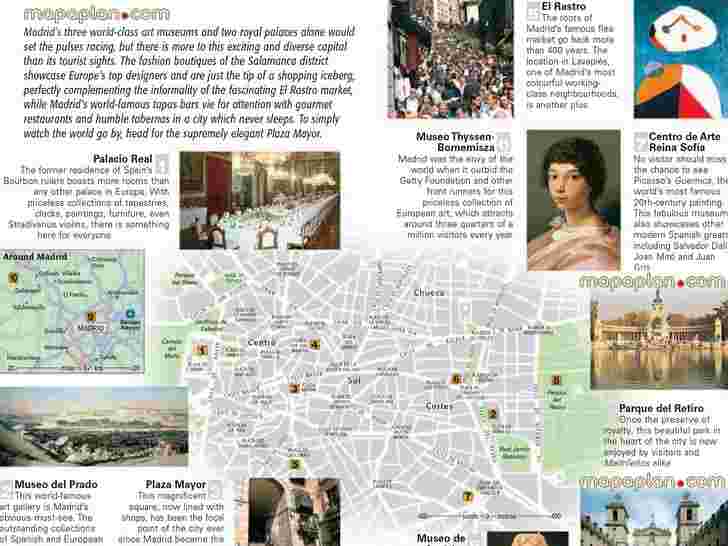
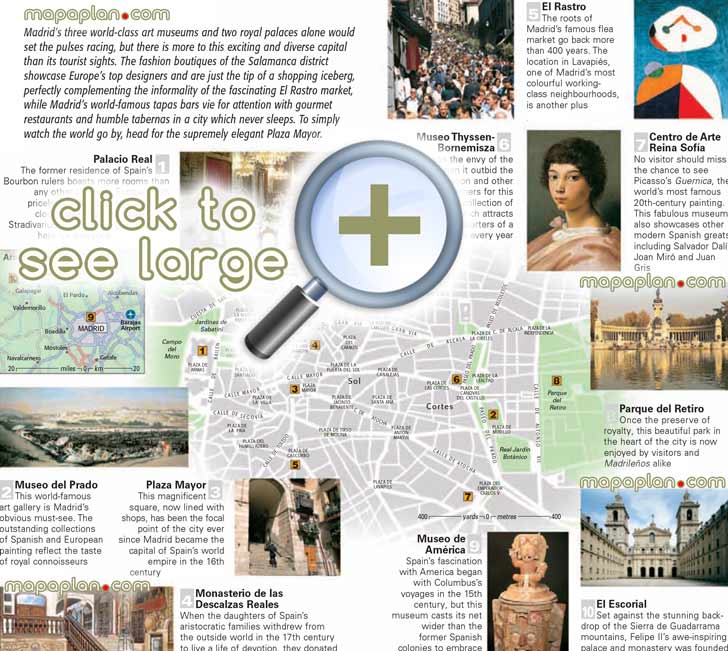
Maps of best attractions in Madrid, Spain
Madrid maps will guide you to the best destinations in the city. Madrid is large but manageable. The major points of interest are located within a relatively confined area bordered in the west by the Palacio Real (Royal Palace) and in the east by the wide avenue known as the Paseo del Prado. The three major museums are situated around the Paseo del Prado, while just to the east of it is the Parque del Retiro and the chance for a perfectly relaxing reprieve from the hyperactive city life. Following the Paseo del Prado north, it comes to be called the Paseo de los Recoletos, which is of less interest to most tourists; it is sided by tall office buildings housing many of the country’s most prominent businesses. Recoletos passes by the upscale Salamanca district in the northeast of the city, popular for its shopping and restaurants. Madrid's top sights, plus hotels, shopping centres, and many of the city’s key landmarks are plotted on our detailed city plans. Public transportation points are also marked, and indicated by the symbols listed in the maps key. Armed with these maps, you should be able to find the accurate location of must-see places. Mapping out a trip to explore Madrid can be far from the usual. This page includes a range of maps and plans which will help you make the most of your visit to Madrid. If you are either a first-time tourist looking for the top 10 must-do sights or if you are returning to Madrid to discover something new - all you need to ensure an enjoyable trip is some advance planning. For some help in narrowing down the options, we present you with a range of high resolution maps which will help you find the detailed locations of the must-see sights - just click on a selected map to access a large version that can be downloaded and printed, or saved onto your mobile device. When in Madrid, you can also get free pocket-size maps of the city from the tourist information centres. Metro stations will in turn provide you with a free map of underground and suburban railway (cercanias) systems.
Central Madrid, Spain visitor's map - Interactive plan showing inner city tourist attractions, main points of interest, museums, landmarks including Chueca, Paseo Del Prado, Parque del Buen Retiro - Madrid top tourist attractions map
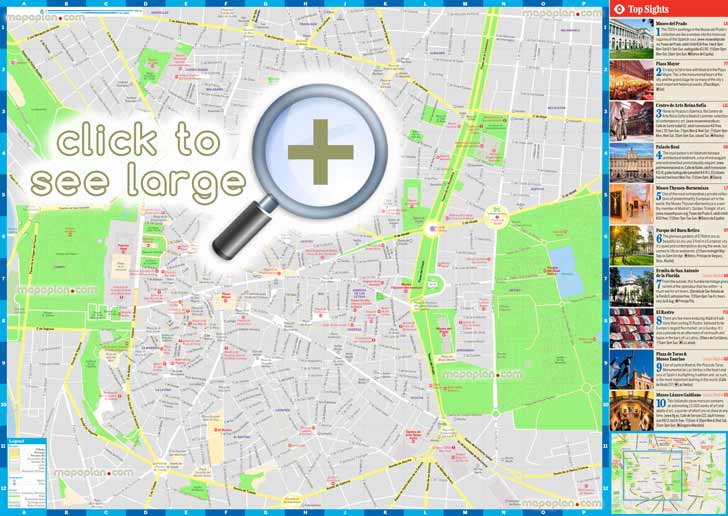
You can view, download or print a full, high resolution (detailed, large) version of this image by clicking on the plan itself
Travel layout guide free download - Offline map showing attractions & places to visit - Inner city 3d plan showing places of interest along with street names & must-see destinations including old town Plaza Mayor - Madrid top tourist attractions map

You can view, download or print a full, high resolution (detailed, large) version of this image by clicking on the plan itself
Printable walking map of favourite attractions, parks & points of interest to visit by tourists - Old town & city centre great Spanish historic spots & best must-see sights - Madrid top tourist attractions map
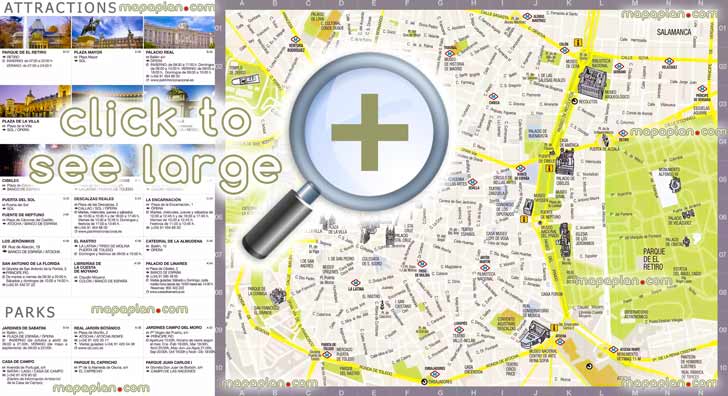
You can view, download or print a full, high resolution (detailed, large) version of this image by clicking on the plan itself
Map of metro & light rail network (Red de Metro, Metro Ligero) public transportation in English & Spanish - Railway stations, routes & stops - Subway tube zones & numbers diagram showing Carcanias suburban train lines network, Barajas Airport Terminal 1, 4 - Madrid top tourist attractions map
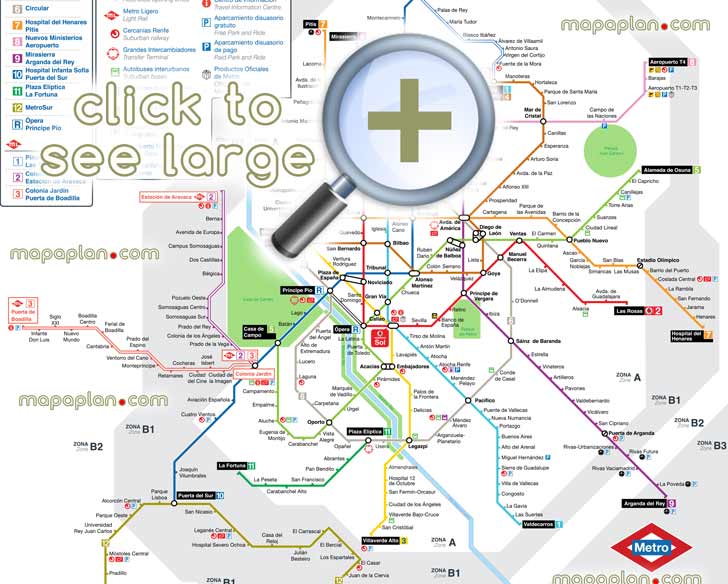
You can view, download or print a full, high resolution (detailed, large) version of this image by clicking on the plan itself
Madrid, Spain city center list of attractions & points of interest - Public transport metro underground transit stations, bus stops, railway bullet train - Locations of the official tourist information centre - High quality road guide & street names large scale plan - Madrid top tourist attractions map
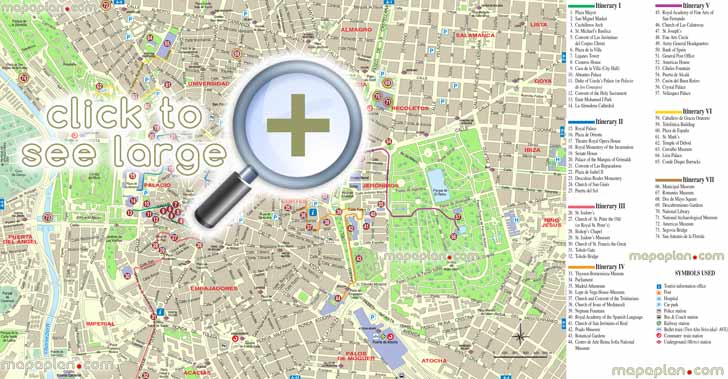
You can view, download or print a full, high resolution (detailed, large) version of this image by clicking on the plan itself
Top attractions in the Greater Madrid metro area in Spain - Virtual map showing best historical buildings, museums, theatres, metro train stations - What to see, where to go, directions to fun things to do in the region - Madrid top tourist attractions map

You can view, download or print a full, high resolution (detailed, large) version of this image by clicking on the plan itself
Plaza Mayor & Museo Del Prado one day walking trip - Simple & easy to navigate 3d aerial satellite view hd map of Madrid inner city centre showing holiday top points of interest, central walkable sites, city-break historical places to visit - Madrid top tourist attractions map

You can view, download or print a full, high resolution (detailed, large) version of this image by clicking on the plan itself
Central Madrid main tourist attractions walking tour printable pop-up map - Key places to visit, churches, theatres, museums - Madrid top tourist attractions map
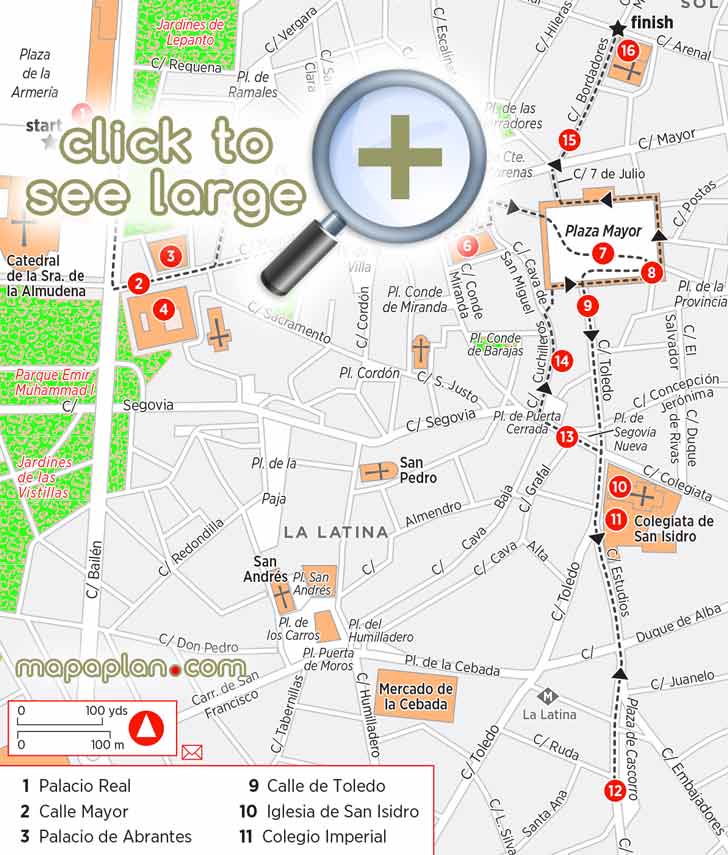
You can view, download or print a full, high resolution (detailed, large) version of this image by clicking on the plan itself
Driving guide & urban navigation directions - Free detailed map of Central Madrid (Centro) streets & roads - Madrid top tourist attractions map

You can view, download or print a full, high resolution (detailed, large) version of this image by clicking on the plan itself
Cercanias suburban rail Renfe commuter map to download - Madrid top tourist attractions map
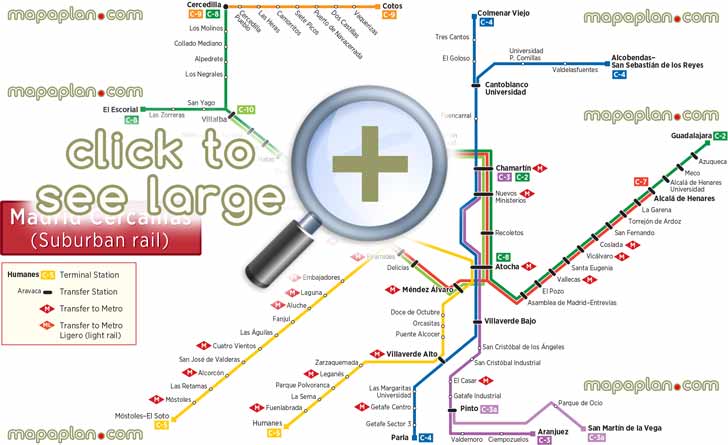
You can view, download or print a full, high resolution (detailed, large) version of this image by clicking on the plan itself
Best of Madrid in 1, 2 & 3 days interactive walking map to print before your trip - Central district area outline layout map of best locations to visit including Puerta del Sol - Madrid top tourist attractions map
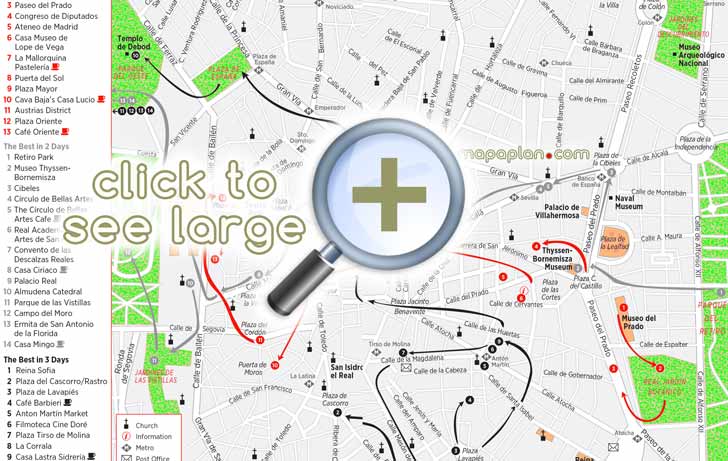
You can view, download or print a full, high resolution (detailed, large) version of this image by clicking on the plan itself
Paseo del Arte map showing the most iconic locations - Printable detailed travel visitors' orientation & navigation walking guide - Madrid top tourist attractions map
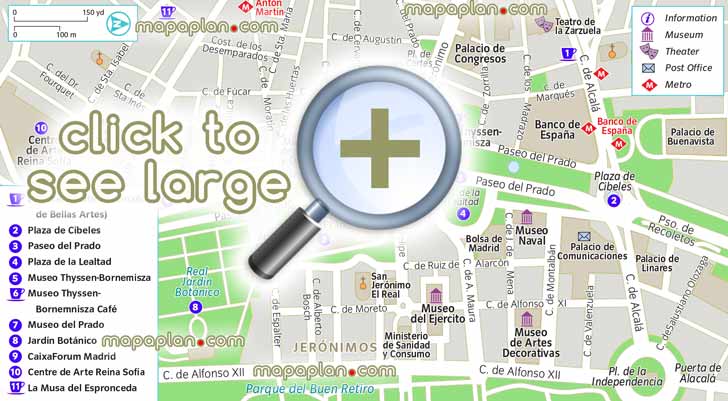
You can view, download or print a full, high resolution (detailed, large) version of this image by clicking on the plan itself
Paseo Del Prado, Parque del Buen Retiro detailed map - Madrid top tourist attractions map
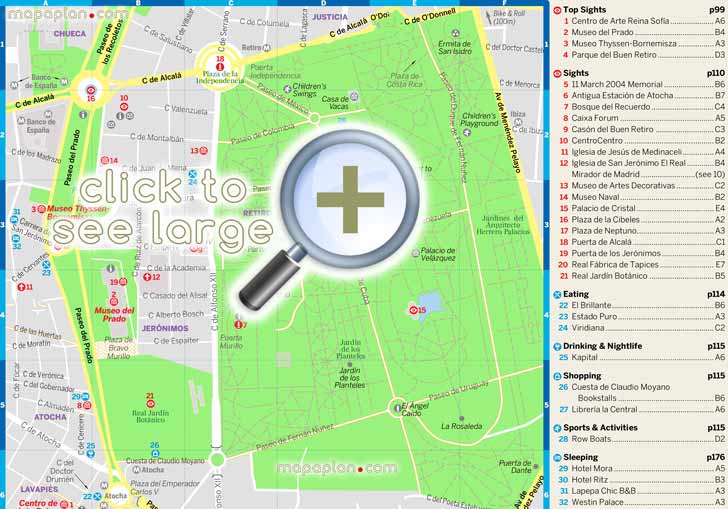
You can view, download or print a full, high resolution (detailed, large) version of this image by clicking on the plan itself
Parque del Retiro best things to do layout - Madrid top tourist attractions map
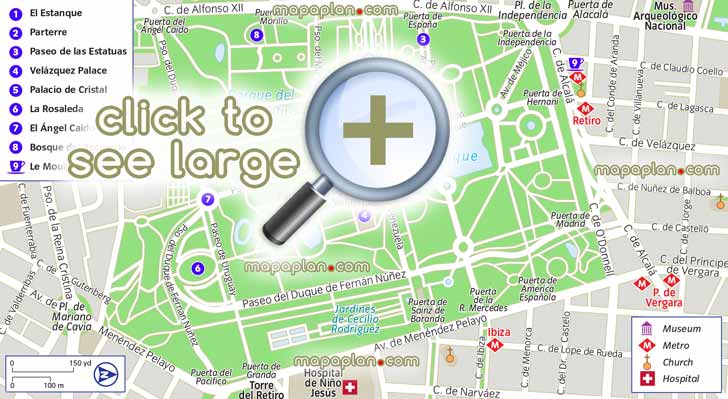
You can view, download or print a full, high resolution (detailed, large) version of this image by clicking on the plan itself
Salamanca 1-day trip itinerary planner - Travel map showing locations to visit, must-see tourist attractions, famous museums destinations, must-do spots & landmark destinations - Madrid top tourist attractions map
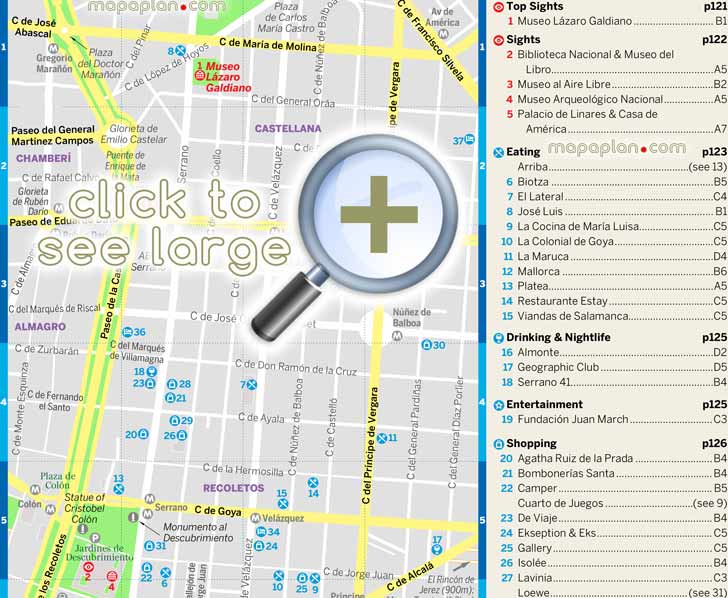
You can view, download or print a full, high resolution (detailed, large) version of this image by clicking on the plan itself
La Latina & Lavapies area map - Madrid top tourist attractions map

You can view, download or print a full, high resolution (detailed, large) version of this image by clicking on the plan itself
Malasana map showing sights, nightlife, shopping, entertainment - Madrid top tourist attractions map
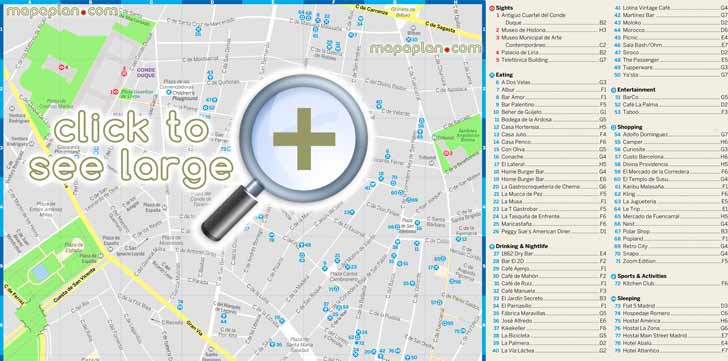
You can view, download or print a full, high resolution (detailed, large) version of this image by clicking on the plan itself
Chamberi area map - Madrid top tourist attractions map
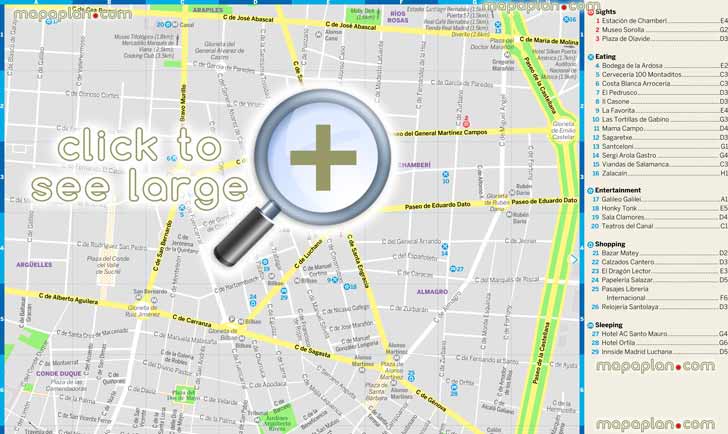
You can view, download or print a full, high resolution (detailed, large) version of this image by clicking on the plan itself
Downtown Madrid map of main hotels and city attractions - Best sights in a week detailed street plan & accommodation guide - Madrid top tourist attractions map
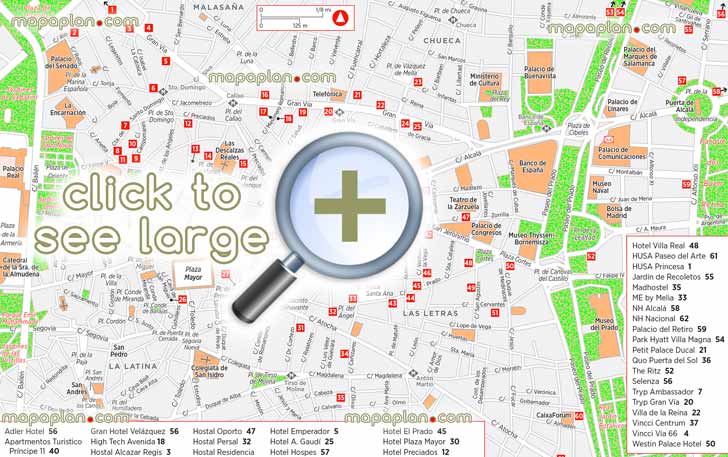
You can view, download or print a full, high resolution (detailed, large) version of this image by clicking on the plan itself
Shopping street map showing major department stores, list of most popular shops, favourite shopping destinations itinerary planner with navigation guide map - Madrid top tourist attractions map
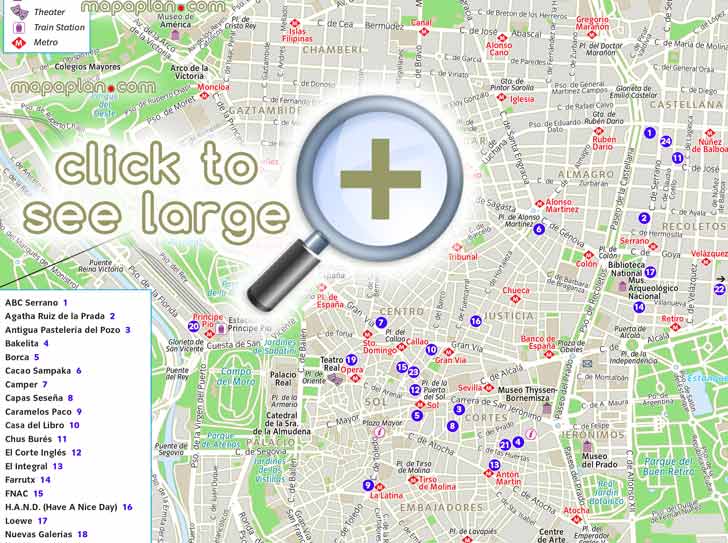
You can view, download or print a full, high resolution (detailed, large) version of this image by clicking on the plan itself
Best restaurants, cafes dining map of Madrid - Madrid top tourist attractions map
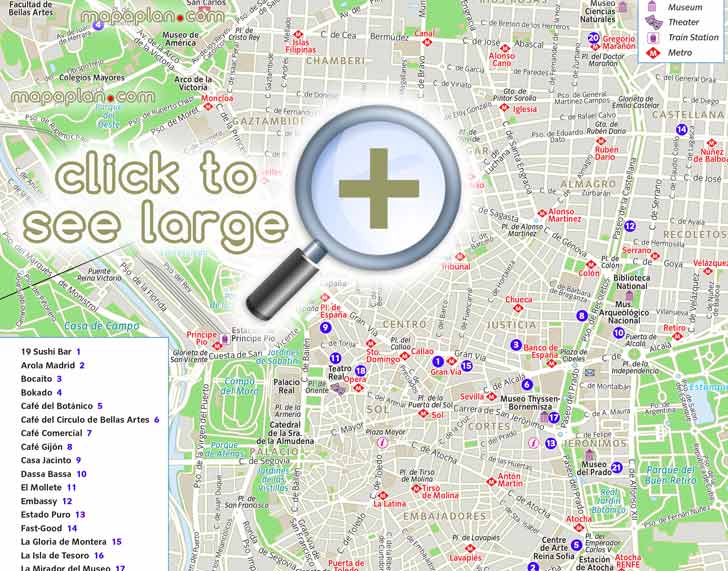
You can view, download or print a full, high resolution (detailed, large) version of this image by clicking on the plan itself
Nightlife, clubs, pubs, bars mapa - Madrid top tourist attractions map
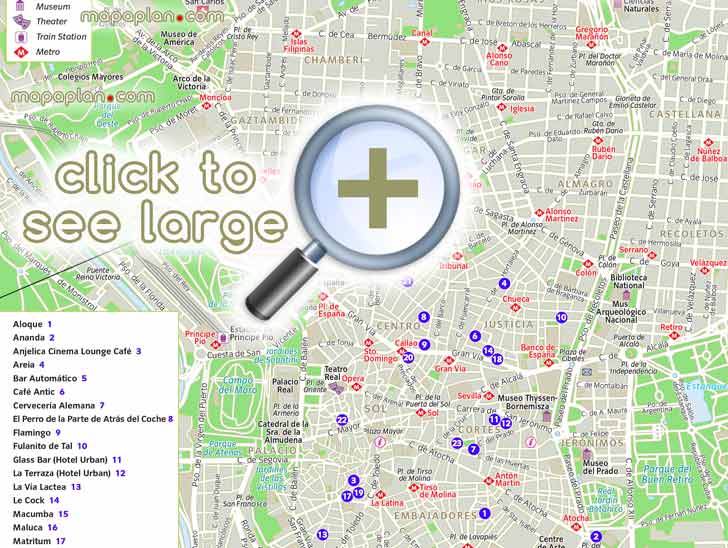
You can view, download or print a full, high resolution (detailed, large) version of this image by clicking on the plan itself
Central Madrid attractions jpg map including Paseo Del Prado, Plaza Mayor, Palacio Real Royal Palace, Museo Thyssen-Bornemisza Fine Arts Museum - Madrid top tourist attractions map

You can view, download or print a full, high resolution (detailed, large) version of this image by clicking on the plan itself
Hop-on hop-off bus map of Madrid City sightseeing tour - Double decker open top red couch visitors' plan showing tour routes - Bird's eye graphical overview of the city trip highlights - Madrid top tourist attractions map
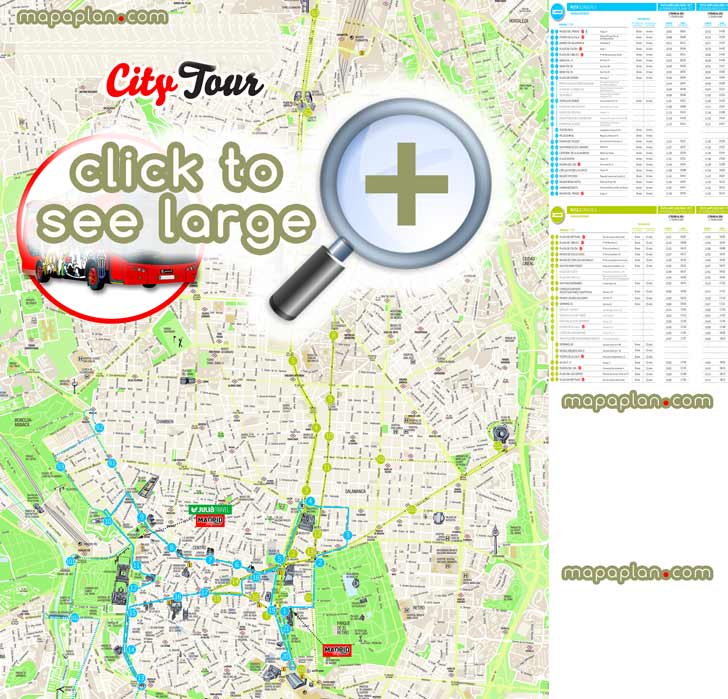
You can view, download or print a full, high resolution (detailed, large) version of this image by clicking on the plan itself
Fun & easy to access places within walking distance - Madrid top tourist attractions map
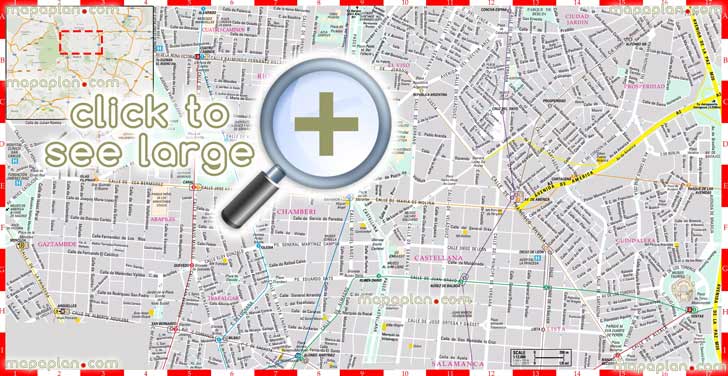
You can view, download or print a full, high resolution (detailed, large) version of this image by clicking on the plan itself
New map showing travel sites & landmarks including Royal Palace, Plaza Mayor, Chueca, Botanical Garden, Atocha Station - Madrid top tourist attractions map

You can view, download or print a full, high resolution (detailed, large) version of this image by clicking on the plan itself
Great family things to do and explore with kids - Fun & interesting ideas where to go around central Madrid area - Free download - Madrid top tourist attractions map
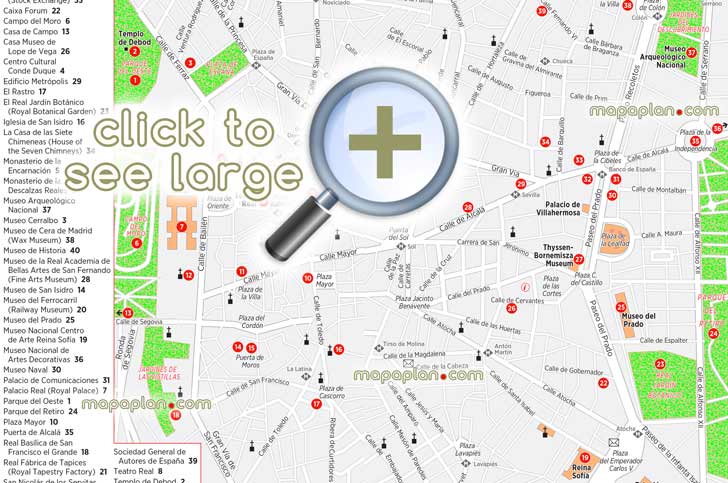
You can view, download or print a full, high resolution (detailed, large) version of this image by clicking on the plan itself
Madrid highlights detailed map showing famous sites to explore including Santiago Bernabeu Stadium - Madrid top tourist attractions map
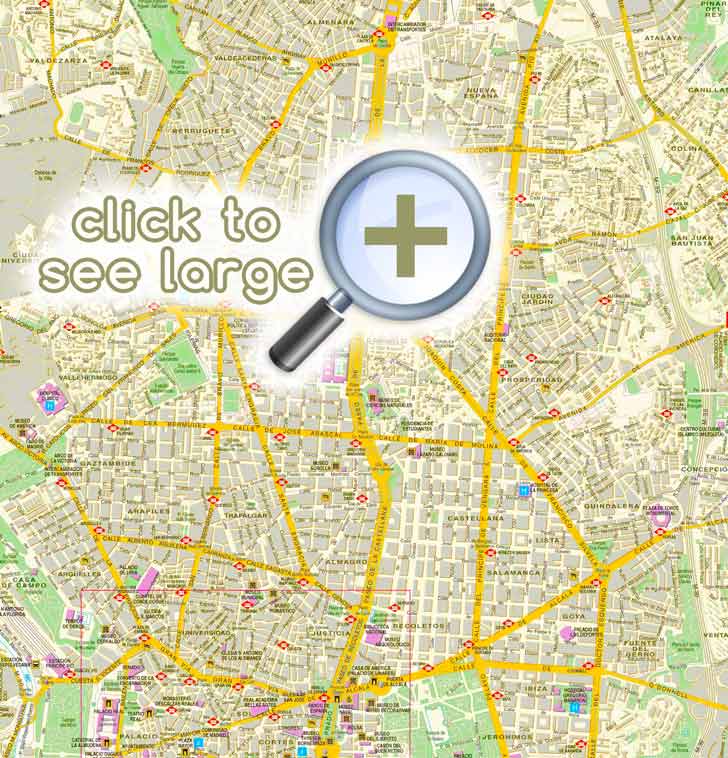
You can view, download or print a full, high resolution (detailed, large) version of this image by clicking on the plan itself
Download the virtual explorer map showing interesting sites & hot spots worth visiting - Madrid top tourist attractions map

You can view, download or print a full, high resolution (detailed, large) version of this image by clicking on the plan itself
Main neighbourhoods plan - Madrid top tourist attractions map
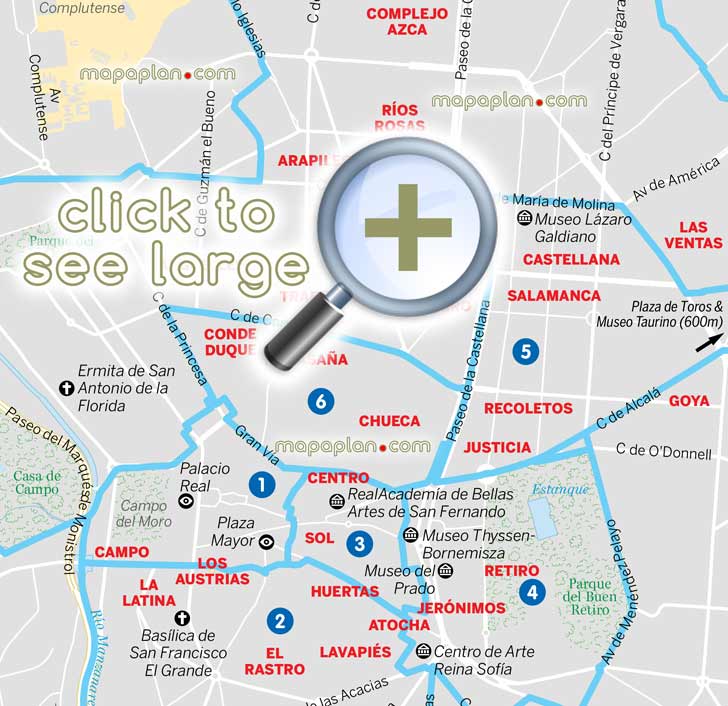
You can view, download or print a full, high resolution (detailed, large) version of this image by clicking on the plan itself
Map of top 10 attractions in Madrid
The typical top ten attractions are listed below. You can find the detailed locations of these places on the maps above.
- Royal Palace (Palacio Real) - Madrid's fabulous Royal Palace, inspired by Bernini's designs for the Louvre in Paris, is one of Europe's outstanding architectural monuments. More than half of the state apartments are open to the public, each sumptuously decorated with silk wall hangings, frescoes and gilded stucco, and crammed with priceless objets d'art. The palace's setting is equally breathtaking. Laid out before the visitor in the main courtyard (Plaza de Armas) is an uninterrupted vista of park and woodland, stretching from the former royal hunting ground of Casa de Campo to El Escorial and the majestic peaks of the Sierra de Guadarrama.
- Prado Museum (Museo del Prado) - One of the greatest art museums in the world, the Prado contains a fabulous array of work from greats such as El Greco, Titian, Bosch, Rubens, Velázquez and Goya. The Prado is one of Madrid's top tourist attractions. At its core is the fabulous Royal Collec tion of mainly 16th- and 17th-century paintings, transferred from palaces around Madrid. The Prado's strongest suit is Spanish painting, the pick of the artists including Goya with 140 paintings and Velázquez with 50. Highlights of the Italian collection include masterpieces by Fra Angelico, Raphael, Botticelli, Titian and Tintoretto. The Prado owns over 100 works by Rubens and can vases by other leading Flemish and Dutch ar tists. The wing designed by Spanish architect Rafael Moneo in the restored cloister of the Jerónimos church hosts temporary exhibitions and Renaissance sculpture from the permanent collection.
- Plaza Mayor - Madrid's most famous square was built on a grand scale. Capable of holding up to 50,000 people, it was intended to impress and still does. Nowadays it's a tourist attraction first and foremost: a place for relaxing over a drink and watching the world go by. Originally known as Plaza de Arrabal ('Outskirts Square') because it lay outside the city walls, Plaza Mayor was completed in 1619. Following a fire in 1791, Juan de Villanueva (architect of the Prado) redesigned the square, adding the granite archways that now enclose it. During its history, Plaza Mayor has been a market, an open-air theatre, a bullring, a place of execution, and a backdrop for tournaments. Its buildings are now mainly used by the city government.
- Monasterio de las Descalzas Reales - As you climb the staircase, look right and you'll see another trompel'oeil feature. On the 'balcony' are Felipe IV and his family – Mariana of Austria, the Infanta Margarita Teresa and the Prince of Asturias, Felipe Próspero. The prince dates the painting by Antonio Pereda, as he died, aged four, in 1661. This award-winning museum is also a working convent – a haven of peace and quiet after the noise and bustle of Puerta del Sol and the Gran Vía nearby. The building started out as a palace, owned by the royal treasurer, Alonso Gutierrez, but in 1555 he sold it to the sister of Felipe II, Juana of Austria, who founded the convent four years later. The nuns were Franciscans, but became known, because of their aristocratic backgrounds, as the 'Barefoot Royals'. The convent is crammed with works of art – paintings, frescoes, sculptures, tapestries, tiles, woodcarvings, embroidered vestments, liturgical gold and silverware – donated by the nuns' wealthy relatives. The church (rarely open to the public) contains the tomb of Juana of Austria.
- El Rastro - This colourful street market in one of the city's oldest working-class neighbourhoods has been going for well over 100 years. The word rastro means 'trail' and refers to the animal innards that were dragged through the streets in the days when this was the site of the main abattoir. The artist Francisco de Goya immortalized the street types here in paintings such as Blind Man with Guitar, while earlier it had been the backdrop for comic satires by playwrights of the Golden Age. Among the most exotic inhabitants were the amazonas, a team of horsewomen who performed at royal receptions in the 16th century and are remembered in Calle Amazonas. The Rastro is best known for its flea market, the most famous in Spain, but there are also dozens of stalls selling new clothes, furniture and antiques.
- Museo Thyssen-Bornemisza - One of the most important art collections in the world, the Thyssen- Bornemisza focuses on European painting from the 13th to the 20th centuries and is the perfect complement to the Prado and Reina Sofía. Wealthy industrialist Baron Heinrich Thyssen-Bornemisza began acquiring Old Masters in the 1920s for his villa in Switzerland. After the baron's death in 1947 his son, Hans Heinrich, added modern masterpieces, including French Impressionists, German Expressionists and the pick of the Russian Avant-Garde, to the collection. This outstanding collection assembled by the Thyssen-Bornemisza dynasty that provides an unprecedented excursion through the history of Western art. In 1993 the state bought the collection for the knock-down price of $350 million.
- Centro de Arte Reina Sofía - The Reina Sofia's collection of 20th- and 21st-century Spanish art is exciting and challenging by turns. The museum, set in a converted hospital, was inaugurated by King Juan Carlos and Queen Sofía in September 1990 and, besides the permanent collection, stages outstanding temporary exhibitions from around the world. The organization is thematic and chronological, beginning with the Basque and Catalan schools of the early 1900s. While most visitors home in on the rooms exhibiting the great masters of the interwar period – Juan Gris, Joan Miró, Salvador Dalí and Pablo Picasso, whose Guernica is the centrepiece of the gallery – lesserknown Spanish painters and sculptors are worth seeking out. Works by the European and American avant-garde provide an international context.
- Parque del Retiro - The Retiro is the city's green lung and the madrilenos' favourite weekend retreat. The aristocracy was first admitted to the former royal grounds in 1767 but it was another century before the gates were opened to the general public. Visitors can enjoy not only the decorative features, which include statues and sculptural arrangements, follies, a formal French garden, lakes and ponds, but the numerous amenities which make the Retiro such a prize attraction. Children make a beeline for the puppet theatre (Sunday performances start at 1pm), while adults may prefer the concerts at the bandstand. There are rowing boats for hire on the lake. Sunday, when there is almost a carnival atmosphere, is the best day to enjoy everything from circus acts and buskers to pavement artists and fortune tellers.
- Museo de America - Often overlooked by visitors, this is one of Madrid's best museums. The collection comprises more than 25,000 items recovered from the Americas, including textiles, ceramics, tools, paintings and sculptures. The star of the show, by general consent, is the fabulous Quimbayas treasure, presented to the museum by the Colombian government in the 19th century. The exhibition is organized in five themed areas: how America was perceived in Europe from the Age of the Discoveries to the 18th century; the reality; the evolution of the native societies; religion; and communication between the nations.
- Royal Monastery of San Lorenzo de El Escorial - Enjoying a suitably majestic setting in the southern foothills of the Sierra de Guadarrama, the El Escorial was commissioned by Felipe II as a mausoleum for the tomb of his father, Carlos I. The name commemorates the victory over the French at St Quentin on the Feast of St Laurence, in 1557. Building began in 1563 and, from the outset, the king took a keen interest in the smallest details of the project, even down to the choice of site. The complex was finally completed in 1595 and comprised a basilica, a royal palace, a monastery, a seminary and a library. This stupendous granite monument to the king's personal aspirations and to the ideals of the Catholic Counter-Reformation still inspires awe, if not always affection.
- Plaza de Santa Ana & Night-Time Huertas - 10 Nights around the Plaza de Santa Ana and neighbouring barrio (district) of Huertas are long, loud and illed with variety. The plaza is both epicentre and starting point of so many epic Madrid nights, with outdoor tables a fabulous vantage point from which to take the pulse of the night and plan your journey through it Within a short radius of the square, live-music venues, old-style sherry bars and sleek rooftop lounge bars for sybarites will get your night going, with legendary Madrid nightclubs nearby.
What are some interesting facts about Madrid?
Madrid Card - This card gives you free entry to several museums as well as unlimited travel on the Madrid Vision tour bus and other discounts. 24-, 48- or 72-hour cards are sold at tourist offices, on Madrid Vision buses or over the internet.
Public Transport - Madrid is a compact city when compared with other European capitals. although most of it can be easily explored on foot, if time is tight don't hesitate to make use of the metro as cross-city trips are rarely more than four or five stops. Buy the economical Metrobus ticket, valid for 10 journeys, or the Tourist Travel Pass. Keep track of the number of rides you've done, to avoid running out (ticket machines indicate how many journeys are left).
Buying a map - It's worth equiping yourself with a good city map before exploring the town. One of the best and most detailed is the Michelin version, which sells at around 6€ in the travel sections of large stores like the Corte Ingles, FNAC, or Casa del Libro (the latter's located near the Gran Via metro stop). The free maps given away by tourist offices and hotels are generally less detailed, giving a mere outline of the fascinating maze of little streets that form the labyrinthine center.
Geography - Five and half million people live in the Madrid Region (Comunidad de Madrid), with approximately three million concentrated in the metropolitan area. This region is situated at the geographical centre of mainland Spain, and is bordered by Castile & Leon, whose domains extend northwards as far as the Cantabrian Range and westwards to nearby Portugal. Stretching away to the south and east are the plains of Castile-La Mancha, which convey the traveller down to the beaches of the Mediterranean. Madrid stands on the Castilian high plateau or tableland (meseta) at a height of 646 metres (2,119 ft.) above sea level, where Barajas Airport is one of the most popular focal points for the forty-nine million tourists who flock to Spain every year. Radiating out from the city's inner hub is a complex rail and road network that speeds travellers to any corner of Spain, to neighbouring France and Portugal, or to the sea frontier with North Africa.
For free - Most of Madrid's world-class attractions have admission fees, and these have, for the most part, been rising steadily over recent years. Even so, a significant number of attractions – from parks and churches to museums and art galleries – remain free, regardless of when you decide to visit. With careful planning, the combination of free attractions and specific times when major sights offer free entry enables you to see the best the city has to offer without burning a large hole in your pocket.
Neighborhoods - Madrid can be divided into two main zones of real interest to visitors: the old traditional Center, with the Puerta del Sol and Gran Vía at its heart and surrounding 17th-century Austrias, and Castizo (traditional) Arguelles, Chueca, Malasana, Chamberí, Sol, Heurtas, Salamanca, and Lavapies districts; and the newer Ensanche (extension) refers to all parts of Madrid built outside of the old city walls from the 18th century onward. This area includes the wide cosmopolitan Castellana Avenue, with its business offices and classy hotels; the grid-planned, once mansion-filled Salamanca barrio, home of some of Madrid's best shops and restaurants; and northern Chamartín district, with its easier-going residential atmosphere.
Orientation - West of the Paseo del Prado is the neighborhood known as Huertas, a traditional literary haunt and home to numerous cafes and tapas bars. Huertas merges with the crowded Puerta del Sol, which is the heart of the city and, for that matter, the country, with roads radiating off in all directions and people doing the same. From here, a number of pedestrian streets funnel crowds northward between department stores and boutique shops to the Gran Vía. This main commercial street runs east-west with theaters and less-than-appealing eateries spanning the length of it. Immediately north of the Gran Vía are the trendy, trashed areas known as Malasana and, just east of it, Chueca, both loaded with raging clubs, hip sipping spots and cheaper shopping choices than that of Sol or Salamanca. To the south and west of the Puerta del Sol is the area generally referred to as Hapsburg Madrid, with its ever-popular Plaza Mayor. South of it is La Latina, full of character and creativity and within sight of El Rastro flea market, along with many of Madrid's most traditional restaurants. Farther south is the white-collar barrio called Lavapies. Northwest of the Plaza Mayor is the oldest district of Madrid, originally a Moorish quarter known as Morería and, finally, the Palacio Real, the grandest vestige of Habsburg Madrid in the area known as Opera.
Nightlife - 7 The legend of Madrid's hedonistic nights was born in the narrow, innercity streets of Malasana and Chueca In gritty and grungy Malasana, hard-living rock venues share punters with elegant 19th-century literary cafes Next door in Chueca, a cool and predominantly gay clientele ills bars and nightclubs to capacity most nights. More than anywhere in the city.
How can I find specific tourist attractions on the map of Madrid?
Our interactive city maps are easy to explore. You can pan, zoom in, and zoom out on the high-resolution map to locate major tourist attractions. Each map highlights key landmarks, making it simple to find the sights you're most interested in, whether it's a famous monument, museum, or other point of interest.
Can I get a visual representation of the area around Madrid?
For some cities, we provide a general view of the area surrounding popular attractions. While this image won't show the exact street-level view, it helps you understand the layout of the neighborhood, showing how the landmarks are situated in relation to other points of interest around Madrid.
Can I explore maps for both tourist attractions and other points of interest?
Yes! Our platform offers maps covering a range of highlights, from top tourist attractions to other noteworthy areas such as parks, restaurants, and entertainment venues. Whether you're planning a visit to a museum or looking for a nearby park, our detailed maps make it easy to find the best spots in the city.
Related keywords
2023, 2024, 2025, 2025, 2026, 2027, 2028, 2029, map, plan, download, print, printable, free, detailed, aerial, bird's eye, satellite, guide, planner, travel, sightseeing, visit, trip, tour, tourist, what to do, where to go, things to do, must see, top attractions, points of interest, places, sites, sights, buildings, spots, destinations, locations, landmark, museum, in a week, in 3 days, one day, city, route, bus, kids, children, top 10, top ten, popular, famous, interesting, highlights, public transport, rail, hotels, updated, metro, subway, underground, tube, downtown, coach, nightlife, pub, monument, satellite, accommodation, transit, transportation, supermarket, children, metro, subway, underground, tube